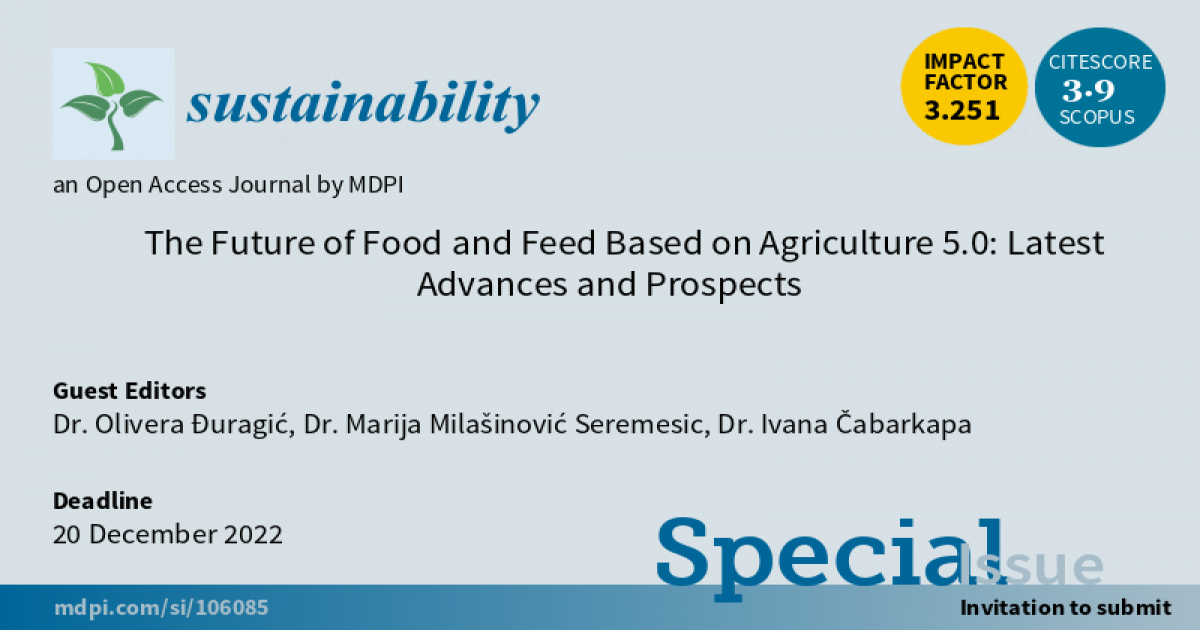The Future of Food and Feed Based on Agriculture 5.0: Latest Advances and Prospects
A special issue of Sustainability (ISSN 2071-1050). This special issue belongs to the section "Sustainable Food".
Deadline for manuscript submissions: closed (31 December 2023) | Viewed by 13565

Special Issue Editors
Interests: feed technology; novel feed ingredients; feed quality and safety
Special Issues, Collections and Topics in MDPI journals
Interests: feed; maize; in vitro digestibility; raw materials
Interests: quality and safety of food and feed; antimicrobial activity of natural compounds
Special Issues, Collections and Topics in MDPI journals
Special Issue Information
Dear Colleagues,
Nowadays, the information available in agriculture can contribute to making cost-effective solutions only when managed efficiently. Improving data management can influence smart agriculture to grow very fast as data have become a key element in modern agriculture. This helps food chain producers to make critical decisions. Benefits arise through objective information obtained by sensors to increase productivity and sustainability. Agriculture based on the management of accurate data results in increased efficiency by reducing resource misuse and environmental pollution. In this way, the foundations are laid for the sustainable agriculture of the future. To improve this situation, everyone in the food chain can make optimized decisions to save money, while protecting the environment and changing the way food will be produced so that the process is sustainable and in line with the growing population on the planet. This new agriculture aims to do as much as possible with as little as possible because a sustainable increase in food production and care for the environment will be crucial in the coming years. Advanced sensor technologies in agriculture can help meet the challenge, and provide detailed information on soil quality, crop status, and environmental conditions that enable the precise application of phytosanitary measures, resulting in a reduced use of herbicides and pesticides, improved water efficiency, and increased crop yield and quality. As a result of all these measures, animal feed and food can also be produced sustainably and efficiently and in line with the challenges facing producers. It is equally important to take care of animal feed, animal husbandry, and products of animal origin, as well as their impact on the environment. Although livestock production requires more resources than plant production, there are situations in which livestock production can also be sustainable. Animal nutrition is a component of livestock production that is a source of income for approximately one billion people. In this regard, it is necessary to better understand the role of animal feed as an important component of a sustainable global food system and develop strategies to connect all sectors in the chain.
At this time, we urgently need interdisciplinary and applied research as well as a link between food and agricultural systems. All this must be achieved through cultural, economic, and political influence to ensure that we produce and distribute food in a more economical and environmentally efficient way than is currently practiced.
In this regard, this Special Issue is expected to address the following topics:
- Data management and smart agriculture;
- Contemporary achievements in agriculture and food and feed production;
- Link between food and agricultural systems;
- Influence of agriculture 5.0 on sustainable food and feed production;
- Social, economical and environmental impact on the whole food chain;
- The role of new technologies in enabling and fostering production.
We look forward to receiving your contributions.
Dr. Olivera Đuragić
Dr. Marija Milašinović Seremesic
Dr. Ivana Čabarkapa
Guest Editors
Manuscript Submission Information
Manuscripts should be submitted online at www.mdpi.com by registering and logging in to this website. Once you are registered, click here to go to the submission form. Manuscripts can be submitted until the deadline. All submissions that pass pre-check are peer-reviewed. Accepted papers will be published continuously in the journal (as soon as accepted) and will be listed together on the special issue website. Research articles, review articles as well as short communications are invited. For planned papers, a title and short abstract (about 100 words) can be sent to the Editorial Office for announcement on this website.
Submitted manuscripts should not have been published previously, nor be under consideration for publication elsewhere (except conference proceedings papers). All manuscripts are thoroughly refereed through a single-blind peer-review process. A guide for authors and other relevant information for submission of manuscripts is available on the Instructions for Authors page. Sustainability is an international peer-reviewed open access semimonthly journal published by MDPI.
Please visit the Instructions for Authors page before submitting a manuscript. The Article Processing Charge (APC) for publication in this open access journal is 2400 CHF (Swiss Francs). Submitted papers should be well formatted and use good English. Authors may use MDPI's English editing service prior to publication or during author revisions.
Keywords
- agriculture 5.0
- food
- feed
- sustainable production
- information
Benefits of Publishing in a Special Issue
- Ease of navigation: Grouping papers by topic helps scholars navigate broad scope journals more efficiently.
- Greater discoverability: Special Issues support the reach and impact of scientific research. Articles in Special Issues are more discoverable and cited more frequently.
- Expansion of research network: Special Issues facilitate connections among authors, fostering scientific collaborations.
- External promotion: Articles in Special Issues are often promoted through the journal's social media, increasing their visibility.
- Reprint: MDPI Books provides the opportunity to republish successful Special Issues in book format, both online and in print.
Further information on MDPI's Special Issue policies can be found here.







